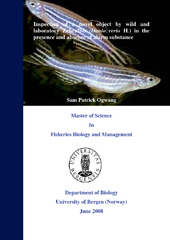| dc.description.abstract | Zebrafish (Danio rerio) is a small Ostariophysian cyprinid fish with no special body armour, which makes them vulnerable to predation. They possess chemical alarm pheromones (Schreckstoff) in the epidermal club cells, which, if released through damaged skin, elicit fright responses in conspecifics. Evidence suggests that domesticated fish are bolder, and thus approach potential predators less cautiously. Whether this boldness persist when alarm substance are involved is the question which this thesis was aimed to answer. The behaviour of wild and laboratory zebrafish towards a novel object was examined in the presence and absence of alarm substance with regards to four behaviour measures; novel object approach, freezing, shoaling and aggression. Fish were subjected to four different treatments; alarm substance, alarm substance plus novel object, distilled water plus novel object and distilled water (the control). Trials were recorded on video-tapes and analyzed. Results showed significant differences between the strains in latency to approach novel object, freezing and shoaling but no difference in aggression. The laboratory fish approached the novel object earlier and froze longer than the wild fish. Wild fish shoaled longer than lab strain and most often in groups of three in contrast to the lab strain where shoals of two were as frequent as shoals of three fish. The presence of alarm substance increased shoal cohesion in both strain but more in the wild strain. Alarm substance also increased freezing duration in the lab strain but not in the wild strain. No effect of novel object or alarm substance was seen in aggression and there was no difference between strains. The presence of a novel object increased shoaling in both strains but more in the wild strain. The results suggest that laboratory zebrafish are bolder than wild strain. The results further adds to the findings that alarm substance induces anti-predatory behaviour in both strains of zebrafish, indicating that the reaction to alarm substance is innate. The choice of which antipredatory response to adopt also seems to depend on experience with predators and energetic cost of the particular response exhibited. | en_US |
